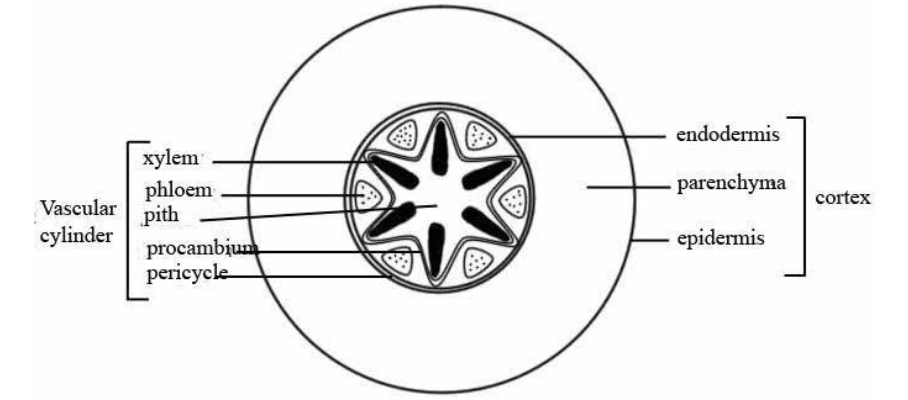
Lateral roots arises from
a. Pericycle
b. Cortex
c. Pith
d. Endodermis.
Answer
581.1k+ views
Hint: The part of a plant that grows under the ground and takes in water and food from the soil is known as root. Here lateral roots arises from cylinder of parenchyma or sclerenchyma cells that lies just inside the endodermis and is the outermost part of the stele of plants
Complete answer:
> PERICYCLE: A thin layer of plant tissue between the endodermis and the phloem is known as pericycle. The cells of the pericycle play an important role during the secondary growth of dicot roots. Cambium is absent in vascular bundles of dicot roots but develops later at the time of secondary growth. So, this option is correct
> CORTEX: A cortex is an outer layer of a stem or root in a plant, lying below the epidermis but outside the vascular bundles. It doesn’t give rise to lateral roots. So this option is incorrect.
> PITH: It is found in the centre. It is made up of parenchymatous cells, which have intercellular spaces. Pith is not well developed in the roots of dicotyledons. Lateral roots don't arise from it. So, this option is wrong.
> ENDODERMIS: an inner layer of cells in the cortex of a root and of some stems, surrounding a vascular bundle. Lateral roots don't arise from this so this option is not correct.
Hence, The correct answer is option (A).
Additional information:
Next to endodermis , lies the pericycle which consists of thick walled parenchymatous cells. The parenchymatous cells of pericycle become meristematic, they divide and give rise to vascular cambium and lateral roots during the period of secondary growth in dicot roots, hence mature cells that are parenchymatous cells are differentiated here.

Note: There are two types of conducting Tissue in plants, namely Xylem and phloem. Xylem helps in the transport of water, and phloem helps in transport of food.
The Pericycle of monocotyledon root is very distinct. The cells of the pericycle give rise lateral roots only, as cambium is absent in Monocots.
Complete answer:
> PERICYCLE: A thin layer of plant tissue between the endodermis and the phloem is known as pericycle. The cells of the pericycle play an important role during the secondary growth of dicot roots. Cambium is absent in vascular bundles of dicot roots but develops later at the time of secondary growth. So, this option is correct
> CORTEX: A cortex is an outer layer of a stem or root in a plant, lying below the epidermis but outside the vascular bundles. It doesn’t give rise to lateral roots. So this option is incorrect.
> PITH: It is found in the centre. It is made up of parenchymatous cells, which have intercellular spaces. Pith is not well developed in the roots of dicotyledons. Lateral roots don't arise from it. So, this option is wrong.
> ENDODERMIS: an inner layer of cells in the cortex of a root and of some stems, surrounding a vascular bundle. Lateral roots don't arise from this so this option is not correct.
Hence, The correct answer is option (A).
Additional information:
Next to endodermis , lies the pericycle which consists of thick walled parenchymatous cells. The parenchymatous cells of pericycle become meristematic, they divide and give rise to vascular cambium and lateral roots during the period of secondary growth in dicot roots, hence mature cells that are parenchymatous cells are differentiated here.

Note: There are two types of conducting Tissue in plants, namely Xylem and phloem. Xylem helps in the transport of water, and phloem helps in transport of food.
The Pericycle of monocotyledon root is very distinct. The cells of the pericycle give rise lateral roots only, as cambium is absent in Monocots.
Recently Updated Pages
Why are manures considered better than fertilizers class 11 biology CBSE

Find the coordinates of the midpoint of the line segment class 11 maths CBSE

Distinguish between static friction limiting friction class 11 physics CBSE

The Chairman of the constituent Assembly was A Jawaharlal class 11 social science CBSE

The first National Commission on Labour NCL submitted class 11 social science CBSE

Number of all subshell of n + l 7 is A 4 B 5 C 6 D class 11 chemistry CBSE

Trending doubts
10 examples of friction in our daily life

One Metric ton is equal to kg A 10000 B 1000 C 100 class 11 physics CBSE

Difference Between Prokaryotic Cells and Eukaryotic Cells

1 Quintal is equal to a 110 kg b 10 kg c 100kg d 1000 class 11 physics CBSE

State the laws of reflection of light

Explain zero factorial class 11 maths CBSE




